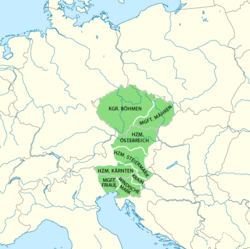This article includes a list of general references, but it lacks sufficient corresponding inline citations. (June 2013) |
Lands of the King of Bohemia Přemyslid state | |||||||||||||
|---|---|---|---|---|---|---|---|---|---|---|---|---|---|
| |||||||||||||
 The Přemyslid state during the reign of Ottokar II | |||||||||||||
 The Přemyslid state (Czech lands are red) in the early 14th century | |||||||||||||
| Status | Personal union of Přemyslids and Luxembourgs, territories of the Holy Roman Empire | ||||||||||||
| Capital | Prague | ||||||||||||
| Common languages | Czech, German, Latin, Polish | ||||||||||||
| Religion | Roman Catholicism Judaism (Jews) Eastern Orthodoxy (incorporated into Catholicism as liturgy) | ||||||||||||
| Government | Feudal monarchy | ||||||||||||
| King | |||||||||||||
| History | |||||||||||||
• Duchy of Bohemia raised to kingdom | 1198 | ||||||||||||
• Bohemian Crown lands established | 7 April 1348 | ||||||||||||
| |||||||||||||
| Today part of | |||||||||||||
The history of the Czech lands in the High Middle Ages encompasses the period from the rule of Vladislav II (c.1110–1174 AD) to that of Henry of Bohemia (c.1265–1335).[1] The High Middle Ages includes the 11th, 12th, and 13th centuries (c. 1000–1299). It was preceded by the Early Middle Ages (the fifth to the tenth centuries) and followed by the Late Middle Ages, which ended about 1500. The High Middle Ages produced a number of intellectual, spiritual and artistic works and saw the rise of ethnocentrism, which evolved into nationalism. The rediscovery of the works of Aristotle led Thomas Aquinas and other thinkers of the period to develop the instructional method of scholasticism. In architecture, many notable Gothic cathedrals were built or completed during this era.
- ^ Čornej, Petr; et al. (2009). Dějepis pro gymnázia a střední školy II. SPN - pedagogické nakladatelství. pp. 61–63. ISBN 9788072354306.



